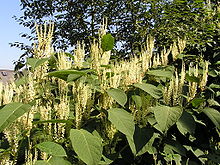Giant knotweed noxious weed comes from the same family as Japanese and Bohemian knotweed. In Colorado, all three knotweeds must be removed, as they are serious pests to all other plants. Here’s a look at all you need to know about what giant knotweed is.
If you see bamboo-like, bright green plans in your garden, there are chances you have giant knotweed. It will usually grow between 5ft and 16ft tall, with hallow, reddish-brown nodes. The stem  bases will join to a membranous sheath, and the leaves are extremely large, alternating their way up the branches.
bases will join to a membranous sheath, and the leaves are extremely large, alternating their way up the branches.
While the knotweeds look similar, you’ll know giant knotweed by the look of the leaves. While Japanese knotweed has bumpy scabers and Bohemian knotweed has a mixture of both plants, giant knotweed has heart-shaped leaves that have long hairs on the underside. During the summer, all knotweeds tend to have white-green flowers developing in blusters, with three-sided, black seeds.
While giant knotweed noxious weed can look pretty, it’s a weed that you need to get rid of. It is one of the most tolerant pests, growing in absolutely any environment or condition possible. This is a noxious weed that spreads quickly and will take over your garden. Just a small seed left behind will infect the garden again. Infestations have been linked to wildlife habitat degrading, bank erosion, and destruction of native vegetation. Nothing else can survive, as the knotweed takes the nutrients for itself.
It is essential that a noxious weed specialist is hired to make sure the giant knotweed management is handled effectively. This is the best way to ensure no more outbreaks occur further into the future. Over the next 10 years you have to watch for any signs of giant knotweed noxious weed to make sure the problem doesn’t return.
Comments are closed.